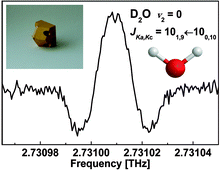High resolution rotational spectroscopy on D2O up to 2.7 THz in its ground and first excited vibrational bending states†
Abstract
We present highly accurate laboratory measurements on the pure rotational spectrum of doubly deuterated water, D2O, in selected frequency regions from 10 GHz up to 2.7 THz. Around 140 rotational transitions in both the vibrational ground and first excited bending states (υ2 = 0,1) were measured in total, involving energy levels with unexcelled high J and Ka rotational quantum numbers. The data give valuable information for the spectroscopic analysis of this molecule. In the case of the light and non-rigid


 Please wait while we load your content...
Please wait while we load your content...